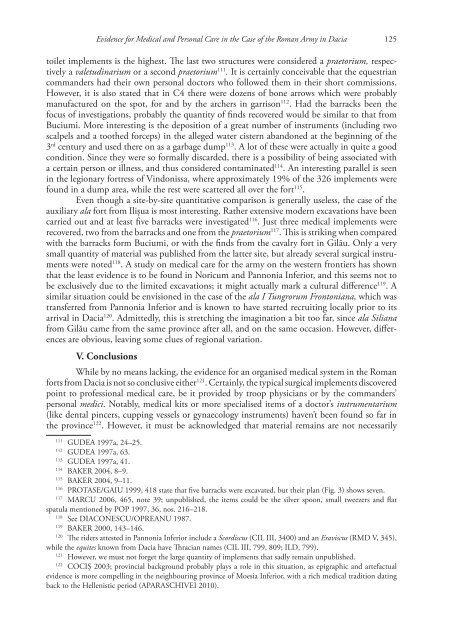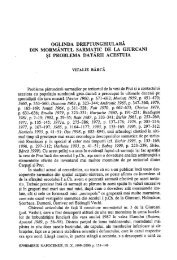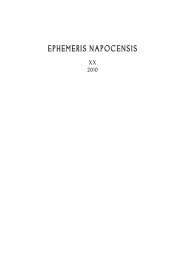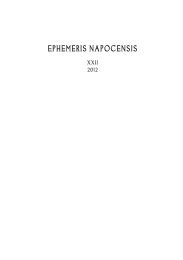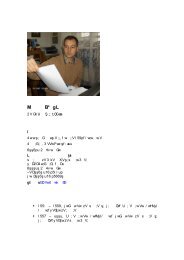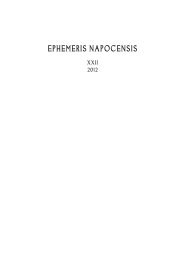ephemeris napocensis 2011 cu corectura.indd - Institutul de ...
ephemeris napocensis 2011 cu corectura.indd - Institutul de ...
ephemeris napocensis 2011 cu corectura.indd - Institutul de ...
You also want an ePaper? Increase the reach of your titles
YUMPU automatically turns print PDFs into web optimized ePapers that Google loves.
Evi<strong>de</strong>nce for Medical and Personal Care in the Case of the Roman Army in Dacia125toilet implements is the highest. The last two structures were consi<strong>de</strong>red a praetorium, respectivelya valetudinarium or a second praetorium 111 . It is certainly conceivable that the equestriancomman<strong>de</strong>rs had their own personal doctors who followed them in their short commissions.However, it is also stated that in C4 there were dozens of bone arrows which were probablymanufactured on the spot, for and by the archers in garrison 112 . Had the barracks been thefo<strong>cu</strong>s of investigations, probably the quantity of finds recovered would be similar to that fromBuciumi. More interesting is the <strong>de</strong>position of a great number of instruments (including twoscalpels and a toothed forceps) in the alleged water cistern abandoned at the beginning of the3 rd century and used there on as a garbage dump 113 . A lot of these were actually in quite a goodcondition. Since they were so formally discar<strong>de</strong>d, there is a possibility of being associated witha certain person or illness, and thus consi<strong>de</strong>red contaminated 114 . An interesting parallel is seenin the legionary fortress of Vindonissa, where approximately 19% of the 326 implements werefound in a dump area, while the rest were scattered all over the fort 115 .Even though a site-by-site quantitative comparison is generally useless, the case of theauxiliary ala fort from Ilișua is most interesting. Rather extensive mo<strong>de</strong>rn excavations have beencarried out and at least five barracks were investigated 116 . Just three medical implements wererecovered, two from the barracks and one from the praetorium 117 . This is striking when comparedwith the barracks form Buciumi, or with the finds from the cavalry fort in Gilău. Only a verysmall quantity of material was published from the latter site, but already several surgical instrumentswere noted 118 . A study on medical care for the army on the western frontiers has shownthat the least evi<strong>de</strong>nce is to be found in Nori<strong>cu</strong>m and Pannonia Inferior, and this seems not tobe exclusively due to the limited excavations; it might actually mark a <strong>cu</strong>ltural difference 119 . Asimilar situation could be envisioned in the case of the ala I Tungrorum Frontoniana, which wastransferred from Pannonia Inferior and is known to have started recruiting locally prior to itsarrival in Dacia 120 . Admittedly, this is stretching the imagination a bit too far, since ala Silianafrom Gilău came from the same province after all, and on the same occasion. However, differencesare obvious, leaving some clues of regional variation.V. ConclusionsWhile by no means lacking, the evi<strong>de</strong>nce for an organised medical system in the Romanforts from Dacia is not so conclusive either 121 . Certainly, the typical surgical implements discoveredpoint to professional medical care, be it provi<strong>de</strong>d by troop physicians or by the comman<strong>de</strong>rs’personal medici. Notably, medical kits or more specialised items of a doctor’s instrumentarium(like <strong>de</strong>ntal pincers, <strong>cu</strong>pping vessels or gynaecology instruments) haven’t been found so far inthe province 122 . However, it must be acknowledged that material remains are not necessarily111GUDEA 1997a, 24–25.112GUDEA 1997a, 63.113GUDEA 1997a, 41.114BAKER 2004, 8–9.115BAKER 2004, 9–11.116PROTASE/GAIU 1999, 418 state that five barracks were excavated, but their plan (Fig. 3) shows seven.117MARCU 2006, 465, note 39; unpublished, the items could be the silver spoon, small tweezers and flatspatula mentioned by POP 1997, 36, nos. 216–218.118See DIACONESCU/OPREANU 1987.119BAKER 2000, 143–146.120The ri<strong>de</strong>rs attested in Pannonia Inferior inclu<strong>de</strong> a Scordis<strong>cu</strong>s (CIL III, 3400) and an Eravis<strong>cu</strong>s (RMD V, 345),while the equites known from Dacia have Thracian names (CIL III, 799, 809; ILD, 799).121However, we must not forget the large quantity of implements that sadly remain unpublished.122COCIŞ 2003; provincial background probably plays a role in this situation, as epigraphic and artefactualevi<strong>de</strong>nce is more compelling in the neighbouring province of Moesia Inferior, with a rich medical tradition datingback to the Hellenistic period (APARASCHIVEI 2010).


